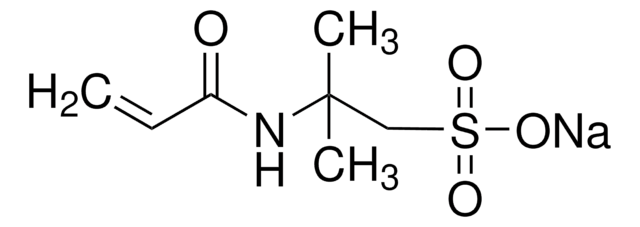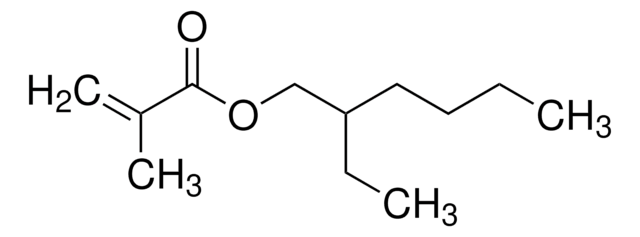251658
3-Sulfopropyl methacrylate potassium salt
98%
Synonym(s):
Methacrylic Acid 3-Sulfopropyl Ester Potassium Salt
About This Item
Recommended Products
Assay
98%
form
solid
mp
295 °C (dec.) (lit.)
SMILES string
[K+].CC(=C)C(=O)OCCCS([O-])(=O)=O
InChI
1S/C7H12O5S.K/c1-6(2)7(8)12-4-3-5-13(9,10)11;/h1,3-5H2,2H3,(H,9,10,11);/q;+1/p-1
InChI key
PNOXUQIZPBURMT-UHFFFAOYSA-M
Related Categories
Application
- Antifouling and flux enhancement of reverse osmosis membrane by grafting poly (3-sulfopropyl methacrylate) brushes: This study explores the enhancement of antifouling properties in reverse osmosis membranes through grafting, addressing significant issues in membrane-based water treatment technologies (Mushtaq et al., 2021).
- Effect of cation alkyl chain length on 3-sulfopropylmethacrylate-based draw solutes having lower critical solution temperature: This article explores the physicochemical properties of ionic liquids derived from 3-sulfopropyl methacrylate, important for developing new materials with specific thermal and solubility properties (Moon et al., 2023).
- Transpicuous-cum-fouling resistant copolymers of 3-sulfopropyl methacrylate and methyl methacrylate for optronics applications in aquatic medium: Discusses the development of copolymers for optical applications, particularly in environments where fouling resistance is crucial, relevant for material science (Mushtaq et al., 2020).
- A general approach for construction of asymmetric modification membranes for gated flow nanochannels: This research introduces a method for modifying membranes with nanochannels using 3-sulfopropyl methacrylate, important for creating selective transport pathways in sensor and separation technologies (Ma et al., 2014).
Signal Word
Warning
Hazard Statements
Precautionary Statements
Hazard Classifications
Skin Sens. 1A
Storage Class Code
11 - Combustible Solids
WGK
WGK 1
Flash Point(F)
Not applicable
Flash Point(C)
Not applicable
Personal Protective Equipment
Certificates of Analysis (COA)
Search for Certificates of Analysis (COA) by entering the products Lot/Batch Number. Lot and Batch Numbers can be found on a product’s label following the words ‘Lot’ or ‘Batch’.
Already Own This Product?
Find documentation for the products that you have recently purchased in the Document Library.
Customers Also Viewed
Our team of scientists has experience in all areas of research including Life Science, Material Science, Chemical Synthesis, Chromatography, Analytical and many others.
Contact Technical Service![[2-(Methacryloyloxy)ethyl]trimethylammonium chloride solution 75 wt. % in H2O](/deepweb/assets/sigmaaldrich/product/structures/316/612/66b0f4cf-d060-427d-b4f5-e8fab3e5cffe/640/66b0f4cf-d060-427d-b4f5-e8fab3e5cffe.png)
![[2-(Methacryloyloxy)ethyl]dimethyl-(3-sulfopropyl)ammonium hydroxide 95%](/deepweb/assets/sigmaaldrich/product/structures/217/219/73c91e1c-0ee4-4b3d-bead-a6dc3d09d1da/640/73c91e1c-0ee4-4b3d-bead-a6dc3d09d1da.png)



![[2-(Acryloyloxy)ethyl]trimethylammonium chloride solution 80 wt. % in H2O, contains 600 ppm monomethyl ether hydroquinone as inhibitor](/deepweb/assets/sigmaaldrich/product/structures/393/326/f7e19585-5431-4220-81b5-f458de6d63d0/640/f7e19585-5431-4220-81b5-f458de6d63d0.png)


![[3-(Methacryloylamino)propyl]trimethylammonium chloride solution 50 wt. % in H2O](/deepweb/assets/sigmaaldrich/product/structures/189/736/089bc8ae-2a98-416d-9f9a-a0a510b6b828/640/089bc8ae-2a98-416d-9f9a-a0a510b6b828.png)



